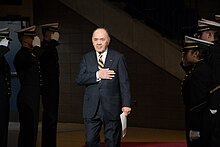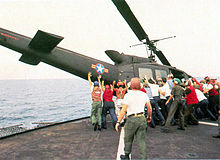Lawrence Cleveland Chambers | |
|---|---|
 Chambers in 2018 | |
| Nickname(s) | "Larry" |
| Born | June 10, 1929 Bedford, Virginia, U.S. |
| Allegiance | United States of America |
| Service/ | United States Navy |
| Years of service | 1952–1984 |
| Rank | Rear admiral |
| Commands held | USS Midway (CV-41) USS Coral Sea (CV-43) Carrier Strike Group Three |
| Battles/wars | Vietnam War |
| Awards | Bronze Star[1] Vietnam Service Medal Meritorious Service Medal |
Lawrence Cleveland "Larry" Chambers (born June 10, 1929) is the first African American to command a U.S. Navy aircraft carrier and the first African-American graduate of the Naval Academy to reach flag rank.[2] While in command of USS Midway during Operation Frequent Wind, Chambers gave the controversial order to push overboard millions of dollars' worth of UH-1 Huey helicopters so Republic of Vietnam Air Force Major Buang-Ly could land on the aircraft carrier in a Cessna O-1 Bird Dog with his wife and five children, thereby saving their lives.[3]
Early life and education[edit]
Born in Bedford, Virginia, in 1929, Chambers was the third of five children[4] raised by his mother, Charlotte Chambers (including his brother Andrew, who later became a lieutenant general in the U.S. Army).[5] After Chambers' father died, his mother began working in the War Department to support the family.
Chambers served in Junior ROTC while attending Dunbar High School in Washington, D.C. After graduating as class valedictorian and commander of the corps of cadets, Chambers considered using the college/university level ROTC program to also pay for college. However, Wesley A. Brown, the first African American graduate of the U.S. Naval Academy, encouraged him to apply there.[5] Chambers did and became the second African American to graduate from the Naval Academy on June 6, 1952.[3][4]
Chambers had mixed feelings about his time at the Naval Academy, not returning to visit for twenty years. He would later say, "While I had some good memories, I also had some tough memories."[6]
Career[edit]
In 1954, after 18 months of flight training, Chambers was designated as a Naval Aviator.[5] His first fleet assignment was to an air-antisubmarine warfare squadron, VS-37, where he flew the Grumman AF Guardian. Transitioning to the light attack community, he later flew the A-1 Skyraider with VA-215 and then, following postgraduate education, transitioned to jet light attack aircraft, flying the A-4 Skyhawk with VA-125 and VA-22. He then established VA-67 (later VA-15) as its first commanding officer, flying the A-7 Corsair II.[7]
From 1968 to 1971, Chambers flew combat missions over Vietnam from USS Ranger and USS Oriskany.[3] In 1972 he was promoted to captain and placed in command of the USS White Plains, a combat stores ship.

In January 1975, Chambers became the first African American to command an aircraft carrier, the USS Midway,[2] serving as the ship's commanding officer until December 1976. After being promoted to rear admiral, Chambers later served as commander of Carrier Strike Group Three and later as interim commander of Carrier Strike Group Four. He finished his career as vice commander of the Naval Air Systems Command.
Operation Frequent Wind[edit]



In April 1975, while in command of the aircraft carrier USS Midway, Chambers was ordered to "make best speed" to the waters off South Vietnam as North Vietnam overran the country to take part in Operation Frequent Wind, the evacuation of U.S. and South Vietnamese personnel. At the time the carrier was in Subic Bay Naval Base with the engineering plant partially torn apart.
Chambers has stated that he received no official order to start the operation, which began on April 29. Instead, when Nguyễn Cao Kỳ, the Vice President of South Vietnam, landed on the flight deck, Chambers figured the operation was underway.[8] Soon the carrier's flight deck was full of helicopters carrying refugees from the fall of South Vietnam.
On that same day, South Vietnamese air force major Buang-Ly loaded his wife and five children into a two-seat Cessna O-1 Bird Dog and took off from Con Son Island. After evading enemy ground fire, Major Buang headed out to sea and spotted the Midway. The Midway's crew attempted to contact the aircraft on emergency frequencies but the pilot continued to circle overhead with his landing lights turned on. When a spotter reported that there were at least four people in the two-place aircraft, all thoughts of forcing the pilot to ditch alongside were abandoned—it was unlikely the passengers of the overloaded Bird Dog could survive the ditching and safely escape before the plane sank. After three tries, Major Buang managed to drop a note from a low pass over the deck:
Can you move the helicopter to the other side, I can land on your runway, I can fly for one hour more, we have enough time to move. Please rescue me! Major Buang, wife and 5 child.
After consultation with the USS Midway Carrier Task Force CO, Admiral William L. Harris, Chambers issued the order to allow the plane to land on the Midway's flight deck.[8] The arresting wires were then removed, all helicopters that could not be safely or quickly relocated were pushed over the side and into the sea. An estimated US$10 million worth of UH-1 Huey helicopters were pushed overboard into the South China Sea. With a 500-foot ceiling, five miles' visibility, light rain, and 15 knots of surface wind, Chambers ordered the ship to make 25 knots into the wind. Warnings about the dangerous downdrafts created behind a steaming carrier were transmitted blind in both Vietnamese and English. To make matters worse, five additional UH-1s landed and cluttered up the deck. Chambers ordered them scuttled as well. Captain Chambers recalled in an article in the Fall 1993 issue of the Naval Aviation Museum Foundatio's Foundation magazine that:
the aircraft cleared the ramp and touched down on center line at the normal touchdown point. Had he been equipped with a tailhook he could have bagged a number 3 wire. He bounced once and came stop abeam of the island, amid a wildly cheering, arms-waving flight deck crew.
Major Buang was escorted to the bridge, where Chambers congratulated him on his outstanding piloting and his bravery. The crew of Midway was so impressed that they established a fund to help him and his family get settled in the United States.[9] The Bird Dog that Major Buang landed is now on display at the National Naval Aviation Museum at Naval Air Station Pensacola, Florida.[10]
At the time, Chambers had only been in command of USS Midway for four or five weeks and believed that his order would get him court martialed.[8] He also called Buang-Ly the "Bravest man I have ever met in my life"[8] and said of his decision to allow Ly to land that "When a man has the courage to put his family in a plane and make a daring escape like that, you have to have the heart to let him in."[11]
Later life[edit]
After retiring from the Navy, Chambers became director of program development at System Development Corporation.[12] In 2010, Chambers took part in commemorations honoring Operation Frequent Wind.[11]
On April 29, 2015, Chambers traveled to San Diego, California, to speak aboard USS Midway, now a museum ship open to the public, in commemoration of the 40th anniversary of Operation Frequent Wind.
References[edit]
- ^ http://www.navsource.org/archives/02/people/chambers_lawrence_c.jpg [bare URL image file]
- ^ a b c Catherine Reef (1 January 2004). African Americans in the Military. Infobase Publishing. pp. 56–7. ISBN 978-1-4381-0775-2. Retrieved 16 March 2013.
- ^ a b D.C. grad ranks high at U.S. Naval Academy, The Afro American, Jun 7, 1952.
- ^ a b c Johnson Publishing Company (November 1981). "Ebony". Ebony. Johnson Publishing Company: 118. ISSN 0012-9011. Retrieved 16 March 2013.
- ^ Robert J. Schneller (19 December 2007). Blue & Gold and Black: Racial Integration of the U.S. Naval Academy. Texas A&M University Press. pp. 99–. ISBN 978-1-60344-000-4. Retrieved 16 March 2013.
- ^ https://www.facebook.com/notes/uss-midway-museum/karls-korner-admiral-lawrence-chambers-the-pathfinder/10153302102097765/ [user-generated source]
- ^ a b c d USS Midway Veterans Recall Fall of Saigon by Maureen Cavanaugh and Natalie Walsh, KPBS, April 29, 2010.
- ^ Shiel, Walt (1995). Cessna Warbirds, pp. 119–120. Jones Publishing. ISBN 1-879825-25-2.
- ^ Watter, Steve. "Clear the Decks." Archived 2008-05-06 at the Wayback Machine Focus on the Family, 2004. Retrieved 9 July 2008.
- ^ a b "Refugees 'come home' to the Midway after 35 years" by Deepa Bharath, The Orange County Register, April 30, 2010.
- ^ Earl G. Graves, Ltd. (August 1985). Black Enterprise. Earl G. Graves, Ltd. pp. 42–. ISSN 0006-4165. Retrieved 16 March 2013.